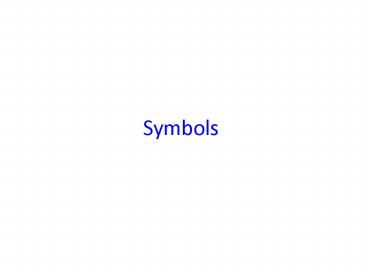Symbols PowerPoint PPT Presentation
Title: Symbols
1
Symbols
2
Types of symbols
- Visual
3
Spatial
4
Kinesthetic
5
Also
- Verbal (spells/prayers words have meaning in
excess of their literal meaning) - Aural (music, drumming)
- Other smell/touch.
6
Metaphor
- Metaphor as building block
- Linking two distinct domains of experience
together - Component we want to know more about is
illuminated by identification with what is known,
e.g. - If heaven IS (like) a garden or palace
- If god IS (like) a king
- Then other imagery to describe heaven or god will
be taken from similar domain
7
Power of symbols
- Symbols conventional
- there must cultural consensus to understand them
- Sometimes arbitrary but seem natural to those
familiar with them - Anthropology of religion is very much about
learning the meaning of symbols
8
(No Transcript)
9
What do we mean when we use symbols?
- Symbols are gateways to understanding
- Provide perspectives by offering new way to
perceive phenomena - Mystical perspective symbols become real
- E.g. Eucharist in Catholicism
10
Symbolic actions, or real?
- Central ritual of Christianity
- Is whats going on -- miracle/magic/symbolic?
- Breadbody/wine/juiceblood
- A cognate of Jewish bread and wine sharing
after services - Transubstantiation vs. primarily
symbolic/memorializing
11
Symbols and action
- What do symbols mean to people as they make sense
of experience? - Symbols concentrate (summarize) lots of
connections together into a singularly powerful
form (the flag, the cross, the idol) - Geertz on how symbols direct and synthesize
thinking to help people make sense of life
12
Motivating symbols
- Victor Turner argued that symbols have cognitive
and emotional elements (what they make people
think and what they make people feel) - Motivate people to action
- Are both cognitive and emotive
- Allow people to think about the world and also
act upon it
13
Belief and coercion?
- Do people all think the same way about symbols or
act in the same way concerning them? - Symbols as collective representations
- Durkheim
- Compliance and defiance
PowerShow.com is a leading presentation sharing website. It has millions of presentations already uploaded and available with 1,000s more being uploaded by its users every day. Whatever your area of interest, here you’ll be able to find and view presentations you’ll love and possibly download. And, best of all, it is completely free and easy to use.
You might even have a presentation you’d like to share with others. If so, just upload it to PowerShow.com. We’ll convert it to an HTML5 slideshow that includes all the media types you’ve already added: audio, video, music, pictures, animations and transition effects. Then you can share it with your target audience as well as PowerShow.com’s millions of monthly visitors. And, again, it’s all free.
About the Developers
PowerShow.com is brought to you by CrystalGraphics, the award-winning developer and market-leading publisher of rich-media enhancement products for presentations. Our product offerings include millions of PowerPoint templates, diagrams, animated 3D characters and more.

